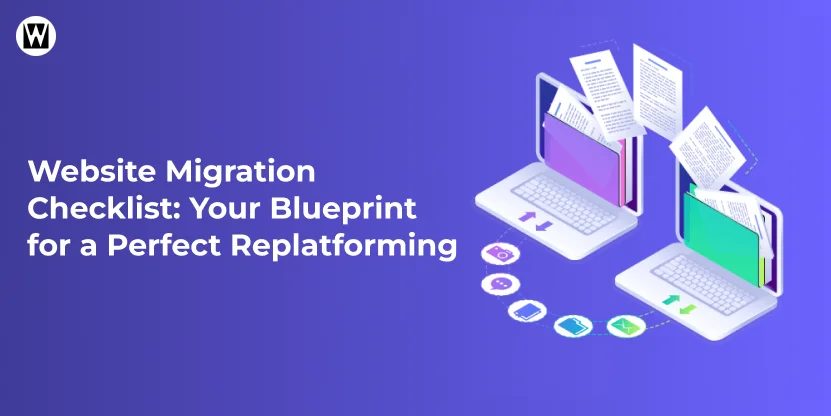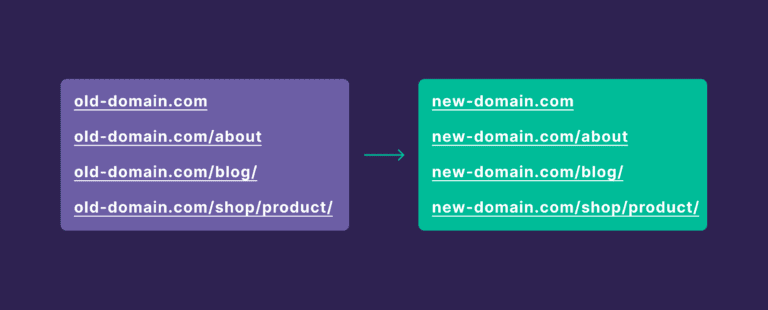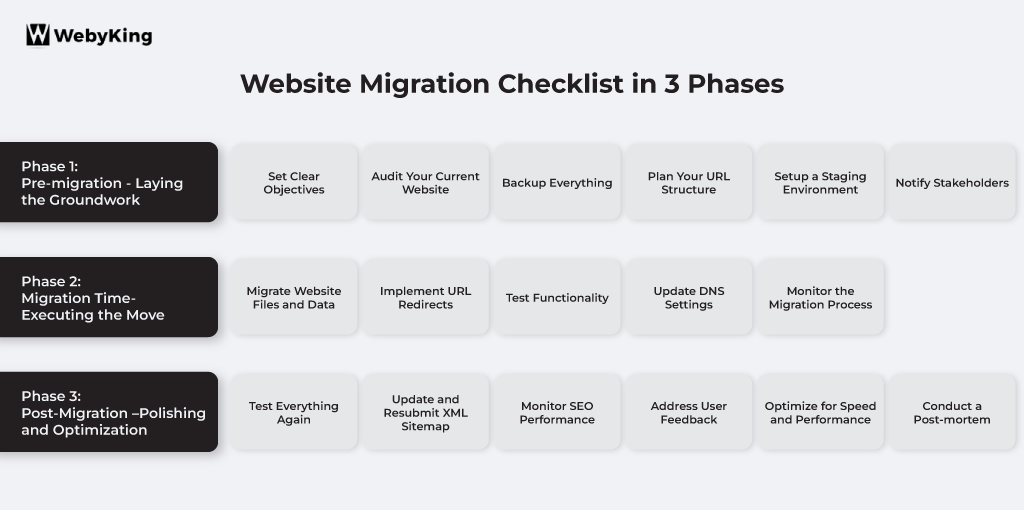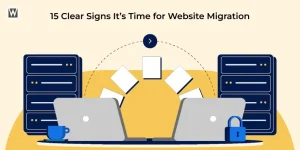Website Migration Checklist: Your Blueprint for a Perfect Replatforming

Is your website in need of more than just a design refresh? A complete website migration might be the solution. Instead of making small design and user experience changes, a full website migration changes everything—from URLs to feature integration to user experience.
Website migration is one of the best ways to reintroduce and relaunch your brand to the world, but it requires a lot of work- and the process doesn’t come without its dangers.
Think of website migration as a high-stakes game of Jenga—every move requires precision to avoid toppling your SEO rankings. And you have to consider each minor thing to avoid an adverse impact on your SEO rankings in search engines.
In this detailed blog, we will explain website migrations and why you may need to migrate your website. We will also share an easy-to-follow website migration checklist to simplify your migration process.
What is Website Migration?
Website migration is like moving houses. Your website, much like a home, occasionally needs to relocate, remodel, or change addresses. Consider that your website is a house on a particular street (or URL). It may occasionally need to be moved to a different street, remodeled, or changed its address.
This may occur if:
- Your website is being redesigned to improve its appearance or speed.
- You’re renaming it (similar to altering the name of a website).
- You’re changing its technology or moving to a new “landlord” (web host).
To prevent visitors from becoming lost during the relocation, you must ensure that everything (such as your pages, images, and links) redirects to the correct location. For search engines like Google to locate the new “house” and continue sending visitors, informing them of the relocation is critical.
A well-defined migration strategy is, therefore, crucial. It helps you stay on course, avoid common mistakes, and sustain your website’s progress.
A website migration or re-platforming might drastically harm your hard-earned SEO ranking if carried out without a comprehensive plan. Any migration should, therefore, be handled like a large project with multiple stakeholders.
Why Might You Migrate a Website?
Businesses do website migration in certain circumstances, including:
- Rebranding or renaming their company
- Changing or updating CMS
- Modifying site structure
- Changing tech stacks that is not possible on the current site
- Building a mobile-first website
- Overhauling the website for better search engine visibility and ranking
Business operations keep changing over time, and the website you built a couple of years ago might not fulfill ongoing criteria and customer preferences. A website migration helps your business keep up with the times and gives site visitors a solid reason to come back.
Types of Website Migration
It’s important to note that the term “ website migration” applies to various projects. To make the most out of the migration checklist, find out the specific type of migration you are going to conduct. Let’s have a look at the most common types:
Platform Migration
A platform migration involves moving a website from one content management system (CMS) to another. This could be due to the outdated technology of the current CMS, the need for better features and functionalities, or simply a desire to switch to a more user-friendly platform.
During a platform migration, it is crucial to ensure that all existing content, images, and data are successfully transferred to the new CMS without losing any valuable information.
Domain Migration
A domain migration occurs when a website changes its domain name, either due to a rebranding effort, a change in business focus, or the acquisition of a new domain.

This type of migration requires careful planning to ensure that all existing SEO value is preserved and that users are seamlessly redirected to the new domain without experiencing any disruptions.
Hosting Migration
A hosting migration involves transferring a website from one web hosting provider to another. This could be driven by the need for better performance, improved security measures, or cost considerations.
During a hosting migration, ensuring that the new hosting environment can support the website’s requirements and that all data is successfully transferred without any downtime is essential.
Changing Website Taxonomy

Parts of your content may need to be transferred to different areas if you reclassify it on your website (for example, by moving posts to new categories and subcategories).
Redirects will be necessary, but only for those categories—not for the entire website, as would be the case with a domain move.
Explore a world of website migration and let our team of experts support you to elevate your experience today!
The Ultimate Website Migration Checklist -Navigating 3 Important Phases

As said earlier, website migration is like moving to a new home; exciting but fraught with challenges if not planned carefully. To ensure a smooth transition, you need to channel three critical phases- pre-migration, migration, and post-migration -each playing a significant role in preserving your website’s functionality, user experience, and search visibility.
Let’s break down each phase step by step.
Phase 1: Pre-migration - Laying the Groundwork
Before you start packing up your website for the big move, detailed planning is key. The pre-migration phase is where you lay the groundwork, ensuring no detail is overlooked.
- Set Clear Objectives: Before initiating the migration, define what you aim to achieve. Are you rebranding, switching to a new CMS, improving site speed, or optimizing your SEO? These goals will guide your entire migration process.
- Audit Your Current Website: Conduct a comprehensive audit of your existing website. This should include:
SEO Audit: Identify top-performing pages, backlinks, and keywords.
Content Audit: Catalog all pages, blog posts, and multimedia files.
Technical Audit: Check for broken links, outdated scripts, and other technical issues. - Backup Everything: Create a full backup of your current website, including files, databases, and third-party integrations. This ensures you have a fallback in case something goes wrong.
- Plan Your URL Structure: Develop a clear URL mapping strategy. If you are changing the URL document the old-to-new mapping to avoid 404 errors and SEO penalties.
- Setup a Staging Environment: Create a staging website to test your site migration. This allows you to make changes without affecting the live site.
- Notify Stakeholders: Keep all stakeholders -developers, content creators, and marketing teams – informed about the migration timeline and objectives.
Ready to Start your Website Migration Journey?
Phase 2: Migration Time- Executing the Move
The migration phase is like a moving day. With your preparation complete, it’s time to finally execute with precision to minimize downtime and disruptions.
- Migrate Website Files and Data: Transfer all files, databases, and content to the new server or CMS. Double-check that all assets, including images, videos, and downloadable files, are intact.
- Implement URL Redirects: Use 301 redirects to point old URLs to their new counterparts. This ensures users and search engines land on the correct pages and helps preserve SEO equity.
- Test Functionality: Before going live, rigorously test the website on the staging environment. Check for broken links, navigation issues, forms and contact details, and mobile responsiveness.
- Update DNS Settings: Point your domain’s DNS settings to the new server. Be prepared for a propagation period, which may take up to 48 hours.
- Monitor the Migration Process: Keep an eye on server logs, error reports, and analytics to catch any issues before launch.
Phase 3: Post-Migration – Polishing and Optimization
- Test Everything Again: Once your site is live, perform a thorough post-launch test. Confirm all the pages load correctly, links work, and the site performs well across all browsers and devices.
- Update and Resubmit XML Sitemap: Generate a fresh XML sitemap and submit it to search engines like Google and Bing. This helps them index your updated website faster.
- Monitor SEO Performance: Track changes in rankings, organic traffic, and bounce rates. Use tools like Google Analytics and Search Console to identify and address any dips.
- Address User Feedback: Encourage users to report issues and take their feedback seriously. This will help you identify problems you might have missed.
- Optimize for Speed and Performance: Run a speed test and optimize any lagging pages. Compress images, enable caching, and consider using a CDN for faster load times.
- Conduct a Post-mortem: Gather your team to review the migration process. Identify what went well and what could be improved for future migrations.
Website migration doesn’t have to be a tedious task. Breaking it into these phases and following this detailed checklist, you can ensure a seamless transition. Remember, preparation is half the battle, execution is important, and post-migration optimization is what sets your site up for long-term success.
Want to optimize your website after migration?
Our experts at WebyKing can help you fine-tune your site for better performance and SEO results. Reach out now for a personalized post-migration plan!
Let’s Make Website Migration Stress-free
At WebyKing, we provide expert website migration services, including website redesigns. From pre-migration audits to post-launch support, we handle the technical details so you can focus on other core business operations. Contact us today as our professional migration services lead to improved user experiences and long-term success in the evolving digital landscape.
Frequently Asked Questions
How much time does it take to migrate a website?
The size and complexity of the website, the scope of the changes being made, and the effectiveness of the migration process are some of the variables that affect how long a website transfer takes. It may take a few days or a few weeks.
How can I reduce downtime when migrating a website?
Minimize downtime by scheduling migrations during off-peak hours, testing in a staging environment, and setting proper redirects.
After a migration, when does traffic start to return to normal?
If everything goes according to plan, a successful website migration won’t result in fewer visitors. However, the time it takes for traffic to return to normal depends on the SEO’s ability to proactively fix any problems when URLs are removed or significant website modifications are made. After the migration, traffic decreases for a few weeks before gradually increasing for the following month or two.
How is the success of a migration in SEO measured?
Traffic and rankings are not the only metrics used to assess the success of SEO migrations. It entails monitoring several variables, including user interaction, technical SEO, organic traffic, search engine rankings, and metrics like backlinks and social media activity.
Whether you’re upgrading technology, improving performance, or rebranding your business, this checklist ensures a smooth and successful migration every step of the way. Get Your Free Checklist Now!


Ravi Makhija, the visionary Founder and CEO of WebyKing, is a seasoned digital marketing strategist and web technology expert with over a decade of experience. Under his leadership, WebyKing has evolved into a premier full service web and marketing agency, delivering innovative solutions that drive online success. Ravi’s deep understanding of the digital landscape combined with his passion for cutting-edge technologies empowers him to consistently exceed client expectations and deliver results that matter.
















